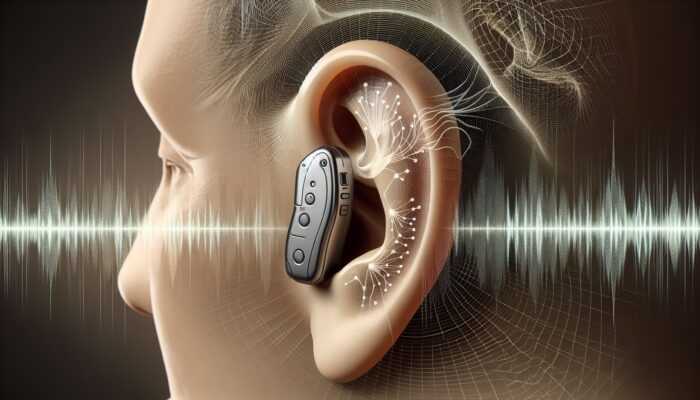Last Updated on 01/05/2025 by Admin
Revolutionizing Hearing Aids with Cutting-Edge Wireless Technology
The field of hearing aid technology is undergoing a remarkable transformation, driven by significant advancements in wireless technology. These developments are creating a radically different experience for users around the globe. Central to this evolution is the enhanced connectivity that is fundamentally changing how individuals with hearing impairments engage with their environment. A key player in this transformation is the improved utilization of Bluetooth technology, which is expanding the range and stability of audio streaming directly to hearing aids. Historically, users faced various connectivity challenges, but innovative solutions are now emerging to deliver a seamless auditory experience that enhances their daily lives.
Maximizing Bluetooth Capabilities for Enhanced Hearing Experiences
Recent enhancements in Bluetooth technology are significantly reshaping the experiences of individuals utilizing hearing aids. Traditionally, users encountered frequent disruptions in connectivity and subpar audio quality. However, the latest advancements now provide improved range, enabling users to maintain a consistent connection over greater distances without sacrificing sound fidelity. This improvement is particularly vital for those who lead active lifestyles or often socialize in larger venues where distance from their devices can hinder communication.
For example, cutting-edge hearing aids integrated with Bluetooth Low Energy (BLE) technology enable reliable connections to smartphones, televisions, and other electronic devices with remarkable stability. This feature proves especially advantageous in dynamic settings like bustling restaurants or lecture halls, where background noise can complicate the auditory experience. The upgraded Bluetooth capabilities not only facilitate better connectivity but also allow users to personalize their hearing settings through smartphone applications. This level of control empowers individuals to customize their auditory experiences to fit their unique requirements, highlighting the transformative impact of these advancements on the industry.
Energy-Efficient Low Energy Protocols Transforming Hearing Aids
The increasing adoption of low energy protocols marks a pivotal moment in the advancement of hearing aid technology. These protocols are specifically engineered to be energy-efficient, significantly prolonging the battery life of hearing devices. Manufacturers are becoming increasingly aware that extended battery life directly correlates with user satisfaction, rendering hearing aids more convenient and dependable for regular use.
On a global scale, users benefit immensely from these innovations, especially in regions where access to replacement batteries may pose challenges. With energy-efficient designs, modern hearing aids can operate for extended periods between charges, alleviating the constant concern of frequent battery replacements. This aspect of contemporary hearing aids aligns perfectly with the ongoing trend toward sustainability and user convenience, as it allows individuals to enjoy the freedom of not being tied to regular charging routines.
Moreover, the incorporation of low energy protocols significantly enhances the overall user experience by ensuring continuous connectivity with various devices. This means users can fully engage in their lives without the anxiety of battery depletion, whether attending a concert in Sydney or delivering a presentation in London.
Seamless Multi-Device Connectivity for Enhanced User Interaction
The capability to connect hearing aids to multiple devices simultaneously represents a groundbreaking advancement in hearing technology. Modern hearing aids allow users to transition seamlessly between devices without the need for manual switching, thereby streamlining the user experience across smartphones, televisions, and computers. This feature provides an unprecedented level of convenience and significantly enhances the overall user experience.
Consider a scenario wherein you are enjoying your favorite program on a smart TV while simultaneously receiving a call on your smartphone. With the latest hearing aids, the audio from the TV can be paused automatically, allowing you to take the call directly through your hearing devices. This integration simplifies everyday tasks and enriches interactions, enabling users to navigate effortlessly between devices without missing crucial information or conversations.
This multi-device capability is particularly advantageous in professional environments, where users may need to shift between conference calls, video meetings, and presentations. The ability to connect to various devices at once facilitates a smoother workflow, ensuring that no important information is overlooked. As technology continues to evolve, the prospects for even more sophisticated multi-device connectivity will redefine user expectations and enhance productivity.
Seamless Integration of Hearing Aids with Smart Devices for Enhanced Control
As technology advances, the integration of hearing aids with smart devices is gaining significant prominence. This evolution transcends mere connectivity; it aims to create a comprehensive auditory experience that enhances control, personalization, and accessibility for users worldwide. The ability of hearing aids to work in harmony with smartphones, smart home systems, and wearable technology is ushering in a new era of hearing solutions.
Unleashing the Power of Smartphone Compatibility in Hearing Aids
Smartphones have become an integral part of our daily lives, and their compatibility with hearing aids is transforming the user experience. Advanced hearing aids are specifically designed to connect seamlessly with smartphones, enabling users to personalize their settings effortlessly. Through dedicated applications, users can adjust volume levels, sound profiles, and even access features such as noise reduction in real-time.
For individuals in bustling urban environments like Tokyo or New York, this compatibility translates to greater control in noisy surroundings. Adjusting settings directly from their phones allows users to enhance speech clarity while minimizing distracting background noise, creating a customized auditory bubble tailored to their specific environments.
Furthermore, these applications are often equipped with user-friendly interfaces that simplify navigation for users of all ages. This level of accessibility is vital in promoting independence among those with hearing impairments, allowing them to manage their hearing devices without relying on external assistance. The ability to control hearing aids via smartphones marks a significant leap toward empowering users and aligning the technology with their lifestyle needs.
Enhancing Home Life Through Smart Home Integration
The fusion of hearing aids with smart home systems represents another exciting frontier in connectivity. Imagine a scenario where your hearing aids are directly linked to your home’s smart devices, enabling automatic adjustments based on your environment. When someone rings the doorbell or your phone receives a call, your hearing aids can alert you through a gentle amplification of these sounds, ensuring you never miss important notifications.
Such integration not only heightens awareness but also promotes independence for users within their homes. Individuals living alone or those facing mobility challenges can greatly benefit from smart technology that connects them with their surroundings. Whether in São Paulo or Berlin, the convenience of smart home integration improves accessibility and enhances the overall quality of life.
Additionally, smart home devices can be programmed to work in harmony with hearing aids, allowing users to experience their environment in a more engaging manner. For example, while watching a movie, the smart home system can adjust the audio settings of the hearing aids to enhance dialogue clarity, creating an immersive experience. This level of integration is expected to expand further, showcasing the limitless possibilities that lie ahead for hearing aid technology.
Synergy Between Wearable Technology and Hearing Aids
The emergence of wearable technology, such as fitness trackers and smartwatches, has opened new avenues for integrating hearing aids. This synergy allows users to monitor their health and adjust hearing aid settings based on real-time data. For instance, fitness trackers can provide insights into physical activity levels, which can influence sound settings according to the user’s environment, such as enhancing audio clarity during workouts.
Moreover, integrating hearing aids with wearable technology provides a more comprehensive understanding of overall well-being. Users can monitor their hearing performance alongside health data, promoting more informed decisions regarding their auditory health. This integration is particularly advantageous for health-conscious individuals, seamlessly merging fitness goals with hearing needs.
Across various global regions, the trend toward health-conscious living is on the rise. As more individuals embrace wearable technology, the expectation is that hearing aids will evolve to support this lifestyle, ensuring users can thrive in diverse environments, whether in a vibrant city or a serene countryside.
Harnessing Artificial Intelligence for Enhanced Hearing Aid Functionality
The integration of Artificial Intelligence (AI) is revolutionizing the capabilities of hearing aids, introducing a new level of sophistication and personalization. From advanced noise cancellation technologies to predictive maintenance features, AI applications are significantly improving the auditory experience for users across the globe. The future of hearing aid connectivity is increasingly reliant on these intelligent solutions, driving enhancements in sound quality, usability, and maintenance.
Transforming Sound Clarity with AI-Driven Noise Cancellation
AI-driven noise cancellation technology is a transformative innovation for hearing aids, substantially enhancing sound clarity. Traditional hearing aids often struggled to differentiate between background noise and speech, leading to frustrating listening experiences. However, with advanced algorithms now integrated into modern devices, hearing aids can identify and filter out unwanted sounds while amplifying speech, thus improving clarity.
This advancement is particularly vital for users in environments filled with noise, such as cafes, public transportation, or busy marketplaces. For instance, picture yourself at a family gathering in a crowded restaurant; AI-powered hearing aids can isolate conversations occurring at your table while suppressing unwanted ambient noise, facilitating meaningful interactions. This level of auditory enhancement not only augments the overall user experience but also promotes social engagement across various cultural contexts.
Additionally, AI’s capacity to learn from user preferences allows for continuous improvements in noise cancellation features. By analyzing common sound environments and user feedback, hearing aids can automatically adapt settings, creating a seamless auditory experience without necessitating manual adjustments. This predictive functionality signifies a major leap forward in hearing technology, making it increasingly user-friendly and effective.
Crafting Personalized Sound Profiles with AI Technology
The future of hearing aids is increasingly centered around their ability to create personalized sound profiles tailored to individual preferences. Leveraging AI technology, hearing aids can learn from user behavior and automatically adjust sound settings according to specific environments and interactions. This level of personalization ensures that every user enjoys an auditory experience that aligns with their unique hearing needs.
For example, a user might prefer different sound settings at home compared to social gatherings or quieter environments. AI-enabled hearing aids can automatically adapt according to these contexts, ensuring optimized sound quality without requiring manual adjustments each time the user transitions between settings. This adaptability enriches the overall user experience and encourages greater acceptance and utilization of hearing aids.
Globally, the potential for personalized sound profiles is immense. As more individuals recognize the advantages of tailored auditory experiences, the demand for AI-driven solutions is expected to rise. This shift not only empowers users in managing their hearing needs but also reflects a broader trend toward customization in technology.
Enhancing Device Longevity with Predictive Maintenance
AI technology is paving the way for predictive maintenance in hearing aids, significantly improving the longevity and performance of these devices. By continuously monitoring performance metrics, AI can detect potential issues before they escalate into major problems. This proactive approach allows users to address maintenance needs early, minimizing downtime and ensuring optimal performance.
For instance, if a hearing aid exhibits early signs of battery depletion or audio distortion, AI can notify the user through its connected application, suggesting timely maintenance actions or service appointments. This anticipatory approach not only prevents unexpected failures but also enhances overall user satisfaction with the device.
In areas where access to hearing healthcare is limited, predictive maintenance provides an essential layer of support. Users can effectively maintain their devices without the need for constant professional oversight, empowering them to take charge of their auditory health. The incorporation of AI in this capacity exemplifies the potential for technology to enhance user experience and accessibility across diverse populations.
Transforming Hearing Healthcare with Telehealth and Remote Adjustments
The rise of telehealth is revolutionizing how users manage their hearing aids, providing unprecedented access to audiological services and support. This shift toward remote consultations and adjustments allows users to connect with healthcare professionals without the limitations of traditional in-person appointments. The future of hearing aid connectivity is increasingly intertwined with this telehealth revolution, enhancing accessibility and convenience for users around the globe.
Breaking Barriers with Virtual Audiology Services
Virtual audiology services are dismantling geographical barriers, enabling users to access professional support no matter their location. Whether in remote areas or urban centers, individuals can connect with audiologists through telehealth platforms and receive personalized assessments and adjustments conveniently. This accessibility is particularly crucial for those in underserved regions where options for hearing healthcare may be limited.
In practice, users can schedule virtual consultations to discuss their hearing requirements, voice concerns, and receive tailored recommendations. This direct line of communication fosters a collaborative approach to hearing care, enhancing overall satisfaction and outcomes. As remote services gain traction, it is anticipated that audiologists will increasingly leverage these platforms to provide ongoing support, ensuring users maintain optimal hearing health.
Moreover, the convenience of virtual consultations allows users to conduct follow-up appointments from the comfort of their homes, reducing the time and stress frequently associated with traditional visits. This flexibility benefits users and enables audiologists to reach a broader audience, effectively bridging the gap between patients and professionals.
Real-Time Data Sharing for Enhanced Hearing Management
Real-time data sharing is another innovative aspect of telehealth that significantly enhances hearing aid management. Through connected hearing aids, users can share performance data with their audiologists, enabling more informed decisions regarding necessary adjustments and maintenance. This continuous feedback loop ensures that audiologists can monitor user progress and promptly address any concerns.
The ability to share data in real-time is especially beneficial for users experiencing significant changes in their hearing needs. For example, if a user reports difficulties in specific environments, their audiologist can analyze performance data and make necessary adjustments remotely, ensuring users receive immediate support. This level of responsiveness not only enhances user trust and satisfaction but also highlights the critical role of connectivity in modern hearing care.
Furthermore, real-time data sharing encourages a proactive approach to managing hearing health. Audiologists can track trends and patterns in user performance, yielding predictive insights that lead to better hearing outcomes. This innovative application of technology strengthens the bond between users and professionals, fostering a collaborative relationship in managing hearing health effectively.
Empowering Users with User-Friendly Interfaces
As telehealth services expand, developing user-friendly interfaces becomes crucial for effective communication between users and audiologists. Mobile applications and online platforms must be intuitive, ensuring users can navigate features easily and access support without frustration. By prioritizing usability, manufacturers can boost user engagement and satisfaction, encouraging individuals to embrace technology in managing their hearing needs.
User-friendly interfaces should account for diverse demographics, catering to individuals of various ages and levels of technological expertise. Simplifying navigation and incorporating visually appealing designs can enhance the user experience, making hearing aids more accessible to individuals from all walks of life. This inclusivity is essential, as it fosters greater adoption rates and encourages users to actively engage with their hearing health.
Moreover, ongoing training and support through these interfaces can empower users to maximize the potential of their devices. With access to tutorials and FAQs, users can quickly learn how to manage settings or troubleshoot issues independently, further enhancing their confidence in using technology. As telehealth continues to evolve, focusing on user-friendly interfaces will be vital in shaping the future of hearing aid connectivity.
Facilitating Remote Training and Support for Users
The demand for remote training and support is increasingly evident as hearing aids integrate into daily life. Users must feel equipped to manage their devices effectively, and remote training can provide the necessary guidance. Through virtual tutorials and support sessions, users can learn how to navigate their hearing aids, ensuring they maximize the benefits of these advanced technologies.
For example, audiologists can conduct online workshops focusing on specific device features, such as adjusting sound profiles or managing connectivity with smart devices. This targeted training instills confidence in users, empowering them to engage with their hearing aids and adapt settings to meet their unique needs.
Additionally, remote support serves as a valuable resource for users encountering difficulties or changes in their hearing. By providing a direct line of communication with professionals, users can receive timely assistance, alleviating the anxiety often associated with troubleshooting. This responsive approach enhances user satisfaction and underscores the importance of connectivity in modern hearing healthcare.
As the telehealth landscape continues to evolve, emphasizing remote training and support will be crucial in ensuring users feel empowered and informed. This focus on education and engagement will foster a sense of community among users, further enhancing the adoption and utilization of hearing aids worldwide.
Ensuring Telehealth Regulatory Compliance for User Safety
As telehealth services expand within the hearing aid industry, ensuring regulatory compliance becomes increasingly vital. Each region has distinct legal and regulatory standards governing telehealth practices, and manufacturers must navigate these complexities to provide safe and effective services. Compliance is essential for fostering trust between users and healthcare providers, allowing users to feel secure in their interactions.
For instance, maintaining patient confidentiality is paramount in telehealth services. Hearing aid manufacturers must implement robust data protection measures to safeguard user information, complying with regulations such as HIPAA in the United States or GDPR in Europe. Ensuring users understand their rights regarding data privacy is crucial in building confidence in telehealth services.
Furthermore, as telehealth becomes more integrated into hearing healthcare, it is critical for professionals to remain informed about evolving regulations. Continuous education and training for audiologists on telehealth compliance will be vital in delivering high-quality services. This commitment to regulatory adherence reflects a broader responsibility to prioritize user safety and satisfaction in the rapidly changing landscape of hearing aid connectivity.
Prioritizing Data Security and Privacy in Hearing Aids
As hearing aids become more interconnected, the significance of data security and privacy is paramount. Users are entrusting sensitive information to their devices, and manufacturers bear the responsibility of protecting this data through advanced technologies and practices. The future of hearing aid connectivity hinges on ensuring that users feel confident in the security of their information.
Implementing Advanced Encryption Technologies for Data Protection
One of the most effective means of safeguarding user data is through the implementation of cutting-edge encryption technologies. By encrypting data transmitted by hearing aids, manufacturers can ensure that sensitive information remains secure, preventing unauthorized access or data breaches. This level of protection is crucial as users share personal data with their devices, including health information and audiology assessments.
Globally, the demand for enhanced data protection is increasing, as individuals become more aware of their privacy rights. Manufacturers must prioritize encryption measures that comply with international standards, ensuring users can trust their hearing aids to safeguard their information. As technology progresses, continuous investment in encryption technologies is essential for maintaining user confidence and satisfaction.
Moreover, educating users about the encryption measures in place can further build trust. By providing transparent information about how their data is protected, manufacturers can reassure users that their information is secure, fostering a sense of safety in their interactions with technology.
Empowering Users with Consent and Control Over Their Data
User consent and control over data usage are fundamental principles in the realm of data security and privacy. As hearing aids collect and transmit data, users must have the ability to consent to its use and understand how their information will be utilized. This level of transparency is vital in promoting user trust and engagement with technology.
Manufacturers should implement straightforward consent processes within their software, allowing users to easily manage their data preferences. For example, users should be able to choose what data they share with audiologists or third-party applications, ensuring they maintain control over their information. This empowerment encourages users to be proactive in managing their hearing health while ensuring their privacy is respected.
Furthermore, ongoing communication about data practices is crucial. As regulations evolve and data usage practices change, manufacturers must keep users informed about their rights and options. This commitment to transparency not only builds trust but also fosters a greater sense of agency among users in managing their hearing needs.
Ensuring Compliance with Data Protection Regulations
Compliance with data protection regulations is a critical aspect of ensuring user security in hearing aid connectivity. Different regions have established laws governing data privacy, and manufacturers must adhere to these standards to protect user information. This commitment to regulatory compliance is essential in fostering trust between users and manufacturers.
For instance, manufacturers operating in the European Union must comply with GDPR, which emphasizes the importance of user consent and data protection. Adhering to these regulations demonstrates a commitment to safeguarding user information and prioritizing privacy in all aspects of hearing aid technology.
Moreover, as telehealth services become more integrated into hearing healthcare, manufacturers must ensure that their practices align with telehealth regulations. This includes maintaining patient confidentiality, protecting sensitive health information, and ensuring that users feel secure in their interactions with audiologists and their devices. By prioritizing compliance, manufacturers can reinforce the importance of user protection and enhance the overall user experience.
Fostering Accessibility and Inclusivity in Hearing Aid Technology
Creating accessible and inclusive hearing aids is an essential goal for manufacturers in the industry. As the global population continues to grow, addressing the diverse needs of users becomes paramount. By focusing on affordability, user-friendly designs, multilingual support, and cultural sensitivity, the future of hearing aid connectivity can ensure that everyone has access to the technology they need.
Developing Affordable Hearing Aid Solutions
The creation of cost-effective hearing aids is critical in increasing accessibility for all users. Many individuals with hearing impairments encounter financial barriers that obstruct their access to necessary devices. Manufacturers have a responsibility to develop affordable solutions that cater to a wide range of incomes, ensuring that everyone can access essential hearing technology.
Innovative approaches, such as modular designs and adjustable features, can help reduce production costs while maintaining quality. By prioritizing affordability, manufacturers can extend their reach to underserved populations, including those in developing countries where access to hearing healthcare is limited. This commitment to inclusivity aligns with broader efforts to ensure that technology is accessible to all, regardless of socioeconomic status.
Additionally, implementing support programs or partnerships with nonprofit organizations can significantly enhance accessibility for those in need. By collaborating with organizations dedicated to hearing health, manufacturers can facilitate access to affordable hearing aids, empowering individuals to engage fully in their lives.
Prioritizing User-Friendly Design for All Ages
User-friendly design is a critical component of hearing aids that enhances usability for people of all ages and abilities. Manufacturers must prioritize intuitive interfaces, comfortable fits, and easy-to-navigate controls to accommodate the diverse needs of users. By incorporating user feedback into the design process, manufacturers can create hearing aids that are accessible and enjoyable to use.
For instance, simplifying control mechanisms, such as using tactile buttons or voice commands, can improve usability for individuals with varying levels of dexterity or technical experience. Additionally, constructing hearing aids to be lightweight and ergonomically designed can enhance comfort, encouraging consistent use.
Globally, this emphasis on user-friendly design can foster greater adoption rates among individuals who may have previously avoided hearing aids due to usability concerns. As manufacturers prioritize accessibility, they can help dismantle barriers preventing users from engaging with hearing technology.
Incorporating Multilingual Support for Global Accessibility
In our diverse world, incorporating multilingual support in hearing aid interfaces and applications is essential for fostering inclusivity. Users should feel comfortable interacting with their devices in their preferred language, allowing for a more personalized experience. By offering multilingual options, manufacturers can ensure that hearing aids cater to a global audience.
This consideration for linguistic diversity is particularly relevant in multicultural regions, where users may speak different languages or dialects. Providing interfaces in multiple languages enhances user satisfaction and promotes a sense of belonging and understanding.
Moreover, as global travel and migration continue to rise, accommodating different languages will become increasingly important. Hearing aids equipped with multilingual support can help bridge communication gaps, ensuring that users can engage effectively in diverse environments.
Designing with Cultural Sensitivity in Mind
Creating hearing aids with cultural sensitivity is essential in addressing the unique needs of diverse user populations. Manufacturers should consider cultural preferences, values, and practices when developing hearing technology, ensuring that devices resonate with users on a personal level. This thoughtful approach fosters a sense of connection and belonging among users, enriching the overall experience.
For instance, cultural perceptions of hearing loss may vary significantly across different societies. By engaging with diverse communities during the design process, manufacturers can gain insights into specific needs and preferences, leading to more tailored solutions.
Additionally, incorporating culturally relevant features, such as customizable aesthetics or language options, can enhance user engagement. This level of sensitivity ensures that hearing aids are not merely functional devices, but also meaningful tools that resonate with users’ identities and experiences.
Implementing Inclusive Community Programs for Hearing Health
Establishing outreach and educational programs to enhance hearing aid adoption among underserved populations is vital for promoting inclusivity in hearing healthcare. Manufacturers can partner with local organizations, schools, and community centers to provide resources and training focused on hearing health.
These programs can address common misconceptions about hearing aids, offering information on available technology and support options. By engaging directly with communities, manufacturers can foster greater awareness and understanding of hearing health, encouraging individuals to seek assistance when needed.
Furthermore, establishing programs that provide financial assistance or access to affordable hearing aids can have a significant impact on underserved populations. By prioritizing inclusivity and accessibility, manufacturers can help bridge the gap in hearing healthcare, ensuring that all individuals have the opportunity to thrive.
Enhancing Environmental Adaptability in Hearing Aids
As hearing aids continue to evolve, environmental adaptability becomes a critical factor in enhancing user experience. Users require devices that can withstand various environmental conditions while offering optimal performance across different settings. By focusing on weather resistance, adaptive sound settings, and durability, manufacturers can ensure their products meet the diverse needs of users worldwide.
Ensuring Weather Resistance for Active Lifestyles
The capability of hearing aids to endure various environmental conditions is vital for users who lead active lifestyles. Weather-resistant hearing aids are designed to withstand rain, humidity, and temperature fluctuations, ensuring reliable performance regardless of external conditions. This adaptability is particularly crucial for users residing in regions with challenging climates, allowing them to engage in outdoor activities without fear of damaging their devices.
For instance, hearing aids equipped with waterproof features can be used during swimming or in rainy conditions, enhancing usability for individuals who enjoy outdoor sports. By prioritizing weather resistance, manufacturers can create devices that align with users’ lifestyles, fostering greater confidence in their hearing technology.
Additionally, the trend toward rugged, durable designs is gaining traction among users seeking long-lasting solutions. By emphasizing materials that withstand wear and tear, manufacturers can ensure their hearing aids remain functional over time, minimizing the need for frequent replacements.
Adaptive Sound Settings for Seamless Transitions
Adaptive sound settings represent a significant advancement in hearing aid technology, allowing devices to automatically adjust based on the surrounding environment. With the integration of sensors and AI algorithms, modern hearing aids can detect changes in noise levels and adjust sound settings accordingly, providing users with optimal auditory experiences.
For example, when transitioning from a quiet library to a bustling street, adaptive sound settings can enhance speech clarity while suppressing background noise, ensuring users can navigate diverse environments effortlessly. This level of responsiveness enhances user satisfaction and encourages greater engagement with their devices.
Moreover, the potential for adaptive sound settings to cater to individual preferences is immense. Users can customize their experiences based on their unique listening habits, promoting a more personalized approach to hearing health. As this technology continues to evolve, the expectation is that adaptive sound settings will become a standard feature in hearing aids, enhancing usability worldwide.
Enhancing Durability and Longevity of Hearing Aids
Ensuring that hearing aids are durable and possess a long lifespan is essential for user satisfaction and confidence in their devices. Manufacturers must consider the wear and tear that hearing aids may experience during daily use, creating products that can withstand the rigors of everyday life.
Durability not only reduces the frequency of replacements but also contributes to overall cost-effectiveness for users. By investing in high-quality materials and robust designs, manufacturers can enhance the longevity of their devices, providing users with reliable solutions that stand the test of time.
Furthermore, as technology continues to advance, integrating durable features such as shock resistance and impact absorption can further enhance the reliability of hearing aids. This focus on durability aligns with a broader commitment to sustainability, ensuring that devices are built to last in various settings.
Implementing Moisture and Humidity Protection in Hearing Aids
Designing hearing aids to resist moisture and humidity is crucial for maintaining functionality in diverse climatic conditions. Users in humid environments often face challenges with moisture affecting their devices’ performance. By incorporating moisture-resistant features, manufacturers can enhance the usability and reliability of hearing aids, ensuring they remain effective even in challenging conditions.
This level of protection is particularly significant for individuals living in tropical or coastal regions, where humidity levels can vary dramatically. By prioritizing moisture and humidity protection, manufacturers can bolster user confidence, allowing individuals to engage fully in their environments without the concern of damaging their hearing aids.
Moreover, implementing moisture-resistant designs ensures that users can continue to enjoy their hearing aids during activities such as exercise or outdoor adventures. This adaptability aligns with the growing trend toward active lifestyles, ensuring that hearing aids remain functional and reliable in various settings.
Exploring Future Trends and Innovations in Hearing Aids
The future of hearing aid connectivity is filled with possibilities, driven by emerging trends and innovations that promise to reshape the auditory technology landscape. From integrating augmented reality to exploring brain-computer interfaces, the potential for advancements is vast. As manufacturers continue to push technological boundaries, users can expect a more immersive and personalized auditory experience.
Integrating Augmented Reality into Hearing Aids
The incorporation of augmented reality (AR) into hearing aids represents an exciting frontier in auditory technology. Imagine hearing aids that not only enhance sound but also enrich visual experiences, providing users with a deeper understanding of their surroundings. AR technology can overlay visual information onto the real world, enhancing users’ ability to interact with their environment.
For instance, AR-enabled hearing aids could provide visual cues for important sounds, such as alerts from home devices or notifications from smartphones. This integration can significantly enhance situational awareness, allowing users to navigate their surroundings with greater confidence. Furthermore, AR technology can offer personalized feedback on auditory experiences, helping users make informed adjustments to their hearing settings.
As AR technology continues to evolve, the potential for enhancing user experiences is limitless. From providing real-time translations in multilingual environments to offering interactive soundscapes, integrating AR can revolutionize the way users engage with the world around them.
Exploring Brain-Computer Interfaces for Direct Control
Research into direct brain-hearing aid communication through brain-computer interfaces (BCIs) is an exciting area of development. BCIs could potentially enable users to control their hearing devices through thought alone, eliminating the need for physical controls or smartphone interfaces. This integration presents an innovative approach to accessibility, particularly for individuals with mobility challenges.
While still in the experimental phase, BCIs hold the potential to drastically change how users interact with their hearing aids. By tapping into neural signals, users could receive auditory input directly from their devices, creating a more seamless auditory experience. This level of integration could redefine what it means to engage with sound, dismantling barriers for individuals with hearing impairments.
As research continues in this area, it is anticipated that BCIs will evolve into viable solutions for users seeking advanced hearing technologies. The implications for auditory health and accessibility are profound, presenting new avenues for connection and engagement in diverse environments.
Revolutionizing Hearing Aids with Nanotechnology Applications
Applications of nanotechnology in hearing aids are set to revolutionize the industry, facilitating the creation of devices that are smaller, more efficient, and capable of delivering enhanced performance. By utilizing nanomaterials, manufacturers can design hearing aids that are lightweight and comfortable while providing powerful sound amplification and processing capabilities.
For instance, nanotechnology can enable the development of smaller microphones and speakers, making hearing aids less obtrusive and more aesthetically pleasing for users. Additionally, nanomaterials can improve battery life and overall device efficiency, ensuring users can enjoy their hearing aids without frequent recharges or replacements.
As nanotechnology continues to advance, the potential for innovative applications in hearing aids is expected to grow. This shift toward smaller, more powerful devices aligns with user preferences for discreet and effective solutions, enhancing the overall auditory experience for individuals worldwide.
Looking Ahead: Final Thoughts on the Future of Hearing Aids
The future of hearing aid connectivity is promising, characterized by technological advancements that aim to improve the lives of users globally. From enhanced wireless connectivity and AI applications to telehealth services and user-centered designs, the industry is poised for significant growth and transformation. By focusing on accessibility, inclusivity, and innovative technologies, manufacturers can ensure that hearing aids become vital tools for individuals seeking to fully engage with the world around them.
Frequently Asked Questions about Hearing Aid Innovations
What key advancements are shaping the future of hearing aid technology?
Key advancements include enhanced Bluetooth connectivity, AI-driven noise cancellation, and integration with smart devices and telehealth services, all of which significantly improve user experience and accessibility.
How does Bluetooth technology enhance hearing aid connectivity?
Recent advancements in Bluetooth enhance range and stability, allowing for seamless audio streaming and multi-device connectivity, which significantly improves the auditory experience in various environments.
What role does AI play in modern hearing aids?
AI enhances hearing aids through personalized sound profiles, effective noise cancellation, and predictive maintenance, enabling users to enjoy tailored auditory experiences that suit their needs.
Why is telehealth significant for hearing aid users?
Telehealth provides remote consultations and adjustments, improving access to audiological services and allowing users to manage their hearing health conveniently from home.
How do hearing aids ensure data security and privacy?
Manufacturers implement robust encryption technologies, ensure user consent and control over data usage, and comply with international data protection regulations to safeguard user information.
What features enhance the accessibility of hearing aids?
Affordability, user-friendly designs, multilingual support, and cultural sensitivity are essential features that improve the accessibility of hearing aids for diverse populations.
How can hearing aids adapt to different environmental conditions?
Modern hearing aids incorporate weather resistance, adaptive sound settings, and moisture protection, ensuring reliable performance in various climates and conditions.
What future trends should we anticipate in hearing aid technology?
Emerging trends include augmented reality integration, brain-computer interfaces, and applications of nanotechnology, which promise to revolutionize user experiences and device capabilities.
Why is community outreach important for hearing aid adoption?
Community programs raise awareness, provide education, and facilitate access to affordable hearing aids, helping underserved populations embrace hearing technology.
How can users effectively manage their hearing aids?
Users can utilize smartphone apps and remote support services for real-time adjustments, training, and monitoring to manage their hearing aids effectively.
The post Hearing Aid Connectivity: A Universal Future Ahead appeared first on The Microsuction Ear Wax Removal Network.



















